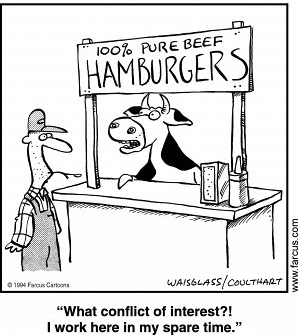The Conflict with Conflict
 Farcus.com [David Waisglass / Gordon Coulhart]
Farcus.com [David Waisglass / Gordon Coulhart]
Conflict, as most of us know it, is commonly defined as a state of disharmony between incompatible or antithetical persons, ideas, or interests. In the world of PR, we view the ability to deal with conflict as a skill set but there is another type of conflict that our potential clients are faced with when selecting a PR agency that directly impacts many PR agencies.
As an agency, we encounter this type of "conflict" when we are invited to a pitch (an opportunity to present our capabilities and team) or are encouraged to submit a request for proposal to an organization that already offers the goods and/or services of a current client.
Here within, lies the conflict with conflict. As presented, companies take issue with PR firms who represent companies that deliver or sell the same goods or services because perhaps they fear the exchange of intellectual capital or proprietary information. But when you secure a client relationship, you sign a legal document that prevents you from sharing said information.
As we see it, the downside is minimal - there is relatively no risk involved when taking on two clients within the same goods or services domain. However, the upside is what far too many companies overlook.
The easiest way to demonstrate is with an example. Take two companies that both sell children's toys. A PR firm represents one already and is asked to represent the other competing organization.
From a purely media relations perspective, the advantages of representing both companies include:
- Developed relationships with the appropriate media outlets and reporters in the children’s toy world including but not limited to toy trade magazines, parenting magazines and social media outlets/bloggers
- Knowledge surrounding toy/gift guide issues of magazines and trade publications including requirements, editorial guidelines, due dates, etc.
- Providing more than one perspective to a reporter regarding the same topic (which enhances the chances of securing the opportunity)
- The ability to identify trends in the space and leverage within the media
With that being said, we understand the obvious concerns that an organization may have if their agency is representing competitors. It is for this reason that transparency and honesty are critical in any business relationship. A client should never feel sandbagged with the news of your representing a rival company. Rather, these conversations should be had from day one and if the current client is uneasy with your working with another organization within the same industry, it is PR practitioner’s responsibility to respect this. It goes with the territory. After all, PR is a business of relationships and it’s important to preserve an open and honest dialog with each your clients.
PR’s core business has always been and will remain one of media results and impressions. As such, companies should reconsider before making the decision to opt out from a PR relationship because of the antiquated (and somewhat irrelevant) rule of conflict. ![]()
